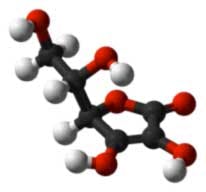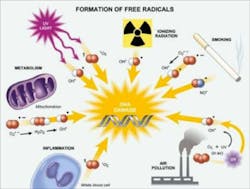Topical antioxidants: an emerging indication of oral disease
Health and wellness claims for antioxidants abound. More and more products are appearing that claim to heal or enhance something, thanks to the amazing power of antioxidants. Consumers and health care professionals do well to examine the products and the claims with measured skepticism.
Nevertheless, over the last several decades, some antioxidants have been the subject of excellent, rigorous scientific studies. The research has shown that various antioxidants do indeed provide significant health benefits and can be incorporated into effective medications and treatments.
Dental medicine is one of the fields that is discovering the efficacy of certain antioxidants. One emerging treatment for periodontitis and other oral disorders is topical antioxidants delivered through dental gel as well as mouth rinses and even toothpastes. This paper will briefly review the basics of antioxidants and various scientific studies that bear out the promise of antioxidants for oral care.
Introduction to antioxidants
Antioxidants are large, complex molecules that are produced by the body and found naturally in various foods and other plants. Antioxidants bond with free radicals, which are unstable molecules with an unpaired electron. When an unstable free radical finds another molecule, it may “steal” an electron to complete its pair. This leaves the second molecule with an unpaired electron, that is, as a new free radical.
This stealing process or electron theft—what is known as oxidation—can become a chain reaction. As antioxidant molecules interact with free radicals they terminate the chain reaction before vital cell molecules are damaged.
Different antioxidants work in different ways. Some stop or retard the chain-reaction process of oxidation. Some act as scavengers, neutralizing circulating free radicals. Antioxidants can be classified as water-soluble or lipid-soluble. Water-soluble antioxidants react with molecules in the blood plasma or with the cytosol inside a cell. Many lipid-soluble antioxidants have a role in protecting cell membranes from per-oxidation of the lipid molecules.
Another important factor that raises the levels of free radicals and ROS is infection. Infection is the body’s response to pathogens, e.g., bacteria. Bacterial invasion triggers the release of chemicals including cytokines (e.g., interleukin 8), chemokines, prostaglandins, and destructive enzymes such as MMPs (matrix metalloproteinases).
These mediators signal for an increase in the number and activity of macrophages and polymorphonuclear neutrophils (PMNs), i.e., white blood cells. As the PMNs attack and ingest the bacteria, they release additional cytokines and in doing so create large quantities of ROS.( 2)
This inflammatory process also results in pain, heat, swelling and redness. Once the pathogen is eradicated, the inflammatory reaction subsides and the balance of ROS and antioxidants returns to normal. However, in some diseases—and gingivitis and periodontitis are common examples—the inflammation does not completely subside. Unchecked ROS or free radicals, such as from extended inflammation or infection, can result in chronic oxidative stress.
It is this chronic oxidative stress and associated tissue damage that is linked to chronic systemic inflammatory diseases. These include cardiovascular disease leading to heart attack and stroke, diabetes, and rheumatoid arthritis. Inflammation and oxidative stress are being implicated in additional disorders such as Alzheimer’s disease, problems with fertility and pregnancy, and even cancer.(3,4,5)
Medical scientists agree that eradicating pathogens with antibiotics continues to be a key strategy in combating chronic disease. However, there is a growing conviction that reducing inflammation and oxidative stress are equally important reducing the risk of chronic, systemic inflammatory disease.(1)
Salivary antioxidants and oral disease
Antioxidants are part of the body’s innate defense mechanism and many occur naturally in saliva. Some salivary antioxidants have some natural antibiotic properties as well. The primary antioxidants in saliva include uric acid, albumin, ascorbic acid, glutathione and antioxidant enzymes. The antioxidants in saliva are critical for fighting free radicals and oxidative stress in the oral cavity. However, the natural levels of saliva may be insufficient to combat high levels of free radicals caused by oral infection, systemic inflammation, or toxic substances.
An extremely common source of chronic inflammation is periodontal disease. It is estimated that some 50 percent of adults in the United States have some level of periodontal disease. The antioxidants in saliva are found to be at abnormally low levels in patients with periodontal disease. Most likely, the antioxidants are depleted as they neutralize the overabundance of free radicals and ROS due to infection and inflammation. (6,2,7,8,9,10)
Increasingly, dental professionals are looking for ways to fight inflammation by increasing the level of antioxidants in the oral cavity. Topical antioxidants that are applied directly to the oral tissues are an emerging technology with great potential.
Antioxidant specificity
Antioxidants have been the subject of research throughout the range of biological science. There are hundreds, if not thousands, of molecules that have antioxidant properties, including enzymes, vitamins, minerals and other nutrients and compounds. Some antioxidants are produced within the body; others must be provided by external sources.
Most antioxidants have enormous, complicated molecular structures. The configuration of atoms and ions makes each antioxidant exquisitely specific in the types of free radicals or other molecules with which they will bond. Scientists are struggling to solve the puzzle of exactly which antioxidants neutralize which free radicals.
Also, research has shown that sometimes combinations of two or more antioxidants work synergistically to multiply the effectiveness of a single antioxidant. The molecular concentration of the antioxidants makes a difference in effectiveness, and many antioxidant molecules are short-lived in their bioactive state.
Because of all the variables involved in antioxidants, laboratory research is laborious and sophisticated. Nevertheless, some prestigious laboratories have persevered to validate the potential of specific antioxidants and antioxidant combinations toward controlling inflammation in oral disease.
Recent antioxidant research
Decades of research have proven that precise combinations of the antioxidants phloretin, tetracurcuminoid and ferulic acid, including formulations applied topically, can neutralize cell-damaging free radicals, particularly those caused by UV rays, nicotine, alcohol, and hydrogen peroxide.(11)
Recent research has further confirmed that certain antioxidants, including phloretin, silymarin, and hesperetin, significantly inhibit the inflammatory response associated with Actinobacillus actinomycetemcomitans, one of the pathogens that cause periodontal disease.(12)
Clinical research also demonstrates the efficacy of topical antioxidants on improving the condition of gingival tissues. In what was designed as a safety study among 100 dental patients, six weeks of using topical antioxidants resulted in a significant improvement in gingival form and color as well as a significant decrease in probing depths. There was also some report of improvement in gingival bleeding and of malodor.(13)
Conclusion: The promise of antioxidants for oral disease
In other words, a limited set of specific antioxidants applied topically are being confirmed as effective in mitigating the inflammation associated with periodontal disease, and, presumably, to reduce the likelihood of progressive oxidative stress and chronic inflammatory disease. New oral care products bearing antioxidants hold a clear promise to be beneficial treatment for periodontitis and oral disease.
References
1. Allen EP. Incorporating Topical Antioxidants in the Dental Practice. DentalTown, April 2012.
2. Chapple I, et al. Reactive oxygen species and antioxidants in inflammatory diseases. Journal of Clinical Periodontology, May 1997.
3. Bahar G, et al. Salivary analysis in oral cancer patients: DNA and protein oxidation, reactive nitrogen species, and antioxidant profile, Cancer, June 2007.
4. Gupta A, et al. Lipid peroxidation and antioxidant status in head and neck squamous cell carcinoma patients. Oxidative Medicine and Cellular Longevity, April-June 2009.
5. Hein C. The new periodontal disease: navigate the emerging solutions. DentistryIQ August 2011.
6. Chapple I. Low antioxidant levels associated with periodontal disease. Journal of the American Dental Association, 2003.
7. Ferreiro B, et al. The Antioxidant Capacity of Saliva. Periodontology, March 2002.
8. Hershkovich O, et al. Age-related changes in salivary antioxidant profile: Possible implications for oral cancer. The Journals of Gerontology. February 2007.
9. Miricescu D., et al. The antioxidant potential of saliva: Clinical significance in oral diseases. Therapeutics, Pharmacology and Clinical Toxicology, June 2011.
10. Sculley DV, et al. Salivary antioxidants and periodontal disease status, Proceedings of the Nutrition Society, 2002.
11. San Miguel S., et al. Bioactive antioxidant mixtures promote proliferation and migration on human oral fibroblasts. Archives of Oral Biology 2011;doi:10.1015/jarchoralbil.2011.01.001
12. Nares S. The anti-oxidants phloretin, silymarin, hesperetin and resveratrol inhibit the inflammatory response of human blood mononuclear cells to lipopolysaccharide.
13. Allen EP. Novel AO Combination: Safety Study. Unpublished research, November 2011.




